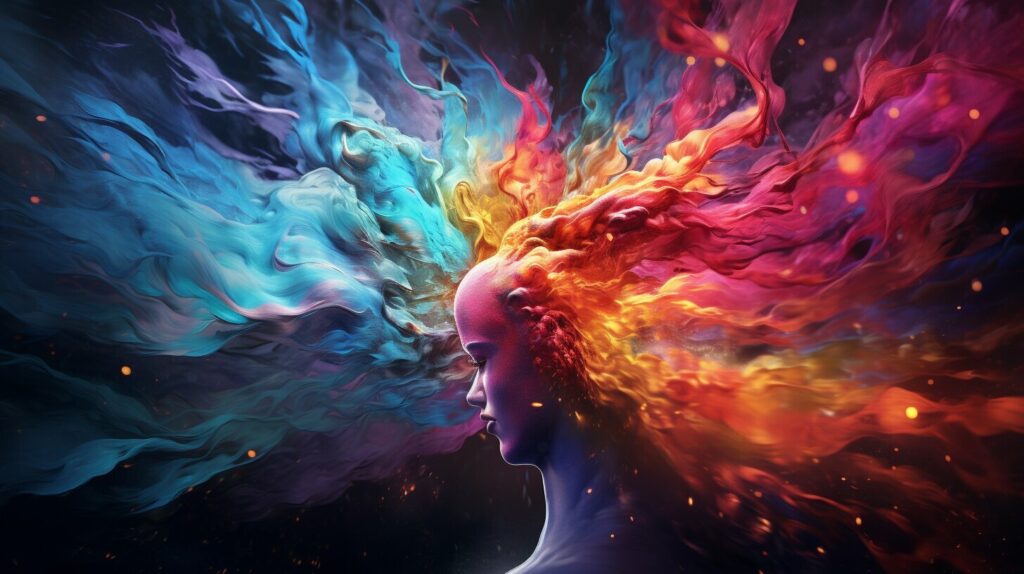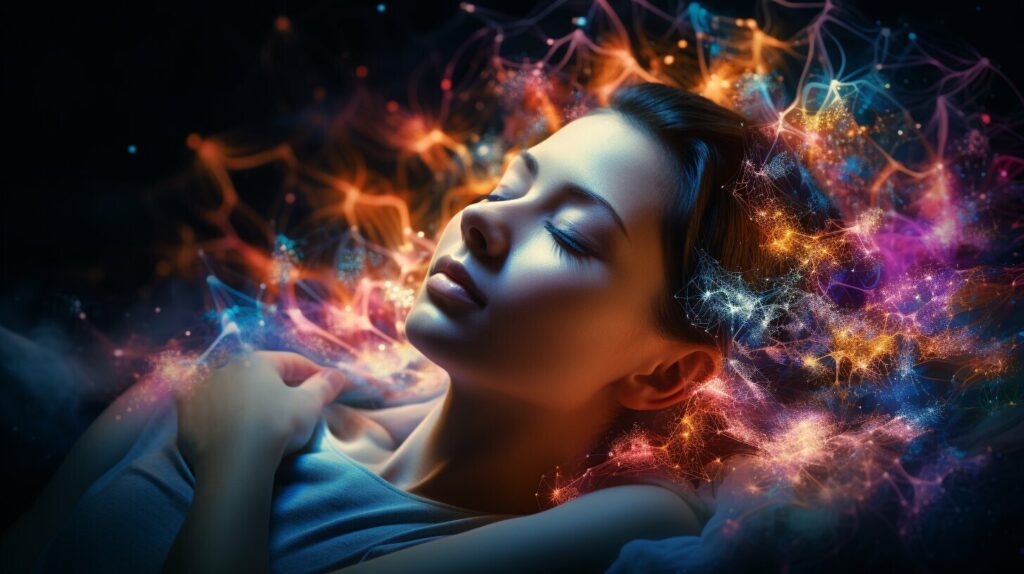Have you ever had a dream that felt incredibly real? Maybe you could smell the ocean breeze, taste the chocolate cake, or feel the tickle of a feather on your skin. These are vivid dreams, and they can be so lifelike that it’s easy to confuse them with reality.
But what about lucid dreams? Are they the same as vivid dreams, or are they something different altogether? This is a question that has puzzled scientists, psychologists, and dreamers alike for years.
In this article, I’ll take a closer look at the distinction between vivid dreams and lucid dreams, exploring their similarities and differences in greater detail. By the end, you’ll have a better understanding of these two mysterious phenomena and what sets them apart.
Key Takeaways:
- Vivid dreams are dreams that feel very lifelike and realistic, often involving intense sensory experiences.
- Lucid dreams are dreams in which the dreamer is aware that they are dreaming and can sometimes even control their dreams.
- While vivid dreams and lucid dreams share some similarities, such as their intensity and emotional impact, they are fundamentally different experiences.
Understanding Vivid Dreams
When we experience a vivid dream, it can often feel like we’re living an alternate reality. Vivid dreams can be incredibly realistic and intense, with vivid sensory experiences and strong emotions. Unlike lucid dreams, we don’t have control over the events and experiences in our vivid dreams, but they can still have a significant impact on our waking lives.
Vivid dreams typically occur during REM (rapid eye movement) sleep, which is the stage of sleep where most dreaming occurs. During this stage, the brain is highly active, processing emotions and memories from the day. This heightened activity can lead to more intense and vivid dream experiences.
One common characteristic of vivid dreams is their ability to elicit strong emotional responses. We may wake up from a vivid dream feeling happy, sad, anxious, or even scared. This emotional processing can be beneficial in helping us work through difficult experiences or emotions in our waking lives.
Another common experience in vivid dreams is the sensation of being fully immersed in the dream world. We may feel like we’re actually interacting with the people and events in our dream, and the sensory experiences can be incredibly vivid. For example, we may be able to taste, smell, and feel objects within the dream world.
Overall, vivid dreams offer a unique and intriguing experience that can provide valuable insight into our subconscious minds. By paying attention to the themes and emotions present in our vivid dreams, we can better understand our thoughts and feelings in our waking lives.

Exploring Lucid Dreams
Lucid dreams are a unique type of dream where the dreamer is aware that they are dreaming and can often control or manipulate the dream in some way. This is in contrast to vivid dreams where the dreamer is fully immersed in the dream world and unaware that they are dreaming.
Lucid dreams can be induced through various techniques such as reality testing, which involves habitually checking during the day if one is dreaming; the Mnemonic Induction of Lucid Dreams (MILD) technique, which involves setting an intention to remember that one is dreaming while falling asleep; or the use of external cues such as light or sound to prompt lucidity.
Once in a lucid dream, the dreamer can explore the dream world with heightened awareness and often has a greater sense of control over their actions and experiences. This can include manipulating objects or even flying through the dream world. Many people report feeling a sense of exhilaration and empowerment during lucid dreams.
Lucid dreaming has been studied extensively by scientists and researchers, with studies indicating potential benefits such as improved problem-solving skills, reduced anxiety, and increased creativity. It has also been used therapeutically to treat nightmares and recurring dreams.
While the exact mechanisms behind lucid dreaming are still not fully understood, research suggests that it may involve increased activity in the prefrontal cortex, the part of the brain responsible for decision-making, attention, and self-awareness.

The potential benefits and intrigue surrounding lucid dreams make them a fascinating subject for study and exploration. Whether you are looking to develop your lucid dreaming skills or simply want to learn more about this unique experience, there is much to discover in the world of lucid dreams.
Similarities between Vivid Dreams and Lucid Dreams
While vivid dreams and lucid dreams have distinct characteristics that set them apart, there are also several similarities between the two.
For one, both types of dreams can be incredibly vivid and intense, with sensory experiences that feel almost as real as waking life. Dreams of this nature are often highly emotional, whether they result in feelings of fear, joy, sadness, or excitement.
Additionally, both vivid dreams and lucid dreams have the potential to be highly memorable and long-lasting, with some dreamers reporting that particular dreams remain with them for years or even decades after they occur.
Despite these commonalities, however, there are also several key differences between vivid and lucid dreams that set them apart from each other.

“Both vivid dreams and lucid dreams have the potential to be highly memorable and long-lasting.”
How Vivid Dreams Differ from Lucid Dreams
While vivid dreams and lucid dreams share some similarities, there are significant differences between the two. The key distinction is that in vivid dreams, the dreamer is not aware they are dreaming. Conversely, in lucid dreams, the dreamer is aware they are dreaming and can consciously control the dream.
In vivid dreams, the dreamer experiences intense sensory experiences and emotions, but they lack the ability to control the dream or consciously make decisions within it. These dreams can be realistic and vivid, but they feel like a normal part of the sleeping experience.
In contrast, lucid dreams involve a sense of self-awareness and control within the dream. The dreamer can recognize they are dreaming and make deliberate decisions about the dream’s direction, manipulating the environment and characters within it. These dreams can feel just as realistic as vivid dreams, but with the added element of control.
One way to distinguish between the two is to ask yourself whether you were in control of your actions during the dream. If you were, it was likely a lucid dream. If you were not aware you were dreaming and had no control over the dream’s events, it was likely a vivid dream.

It’s important to note that vivid dreams and lucid dreams can occur at any stage of sleep and can happen to anyone. However, some people may have a greater propensity for lucid dreaming, and certain techniques can be used to help encourage and induce them.
The Science Behind Vivid Dreams
Vivid dreams can feel incredibly real, almost as if they are occurring in real life. But what causes these intense dreams?
According to research, vivid dreams occur during the rapid eye movement (REM) stage of sleep, which typically happens several times throughout the night. During this stage, the brain is highly active and experiences increased blood flow, leading to the vivid sensory experiences and emotions of the dream.
Additionally, certain emotional and psychological factors can contribute to the occurrence of vivid dreams. Stress, anxiety, and trauma can all heighten the intensity of a dream, making it feel particularly vivid and memorable.
Research has also found a link between memory consolidation and the occurrence of vivid dreams. While we sleep, our brains process and consolidate memories from the day, which can lead to the incorporation of these memories into our dreams. This can result in particularly vivid dreams that relate to our daily experiences.

Overall, while the exact mechanisms behind vivid dreams are not fully understood, research has been able to shed some light on the factors that contribute to their occurrence. By better understanding the science behind vivid dreams, we can gain greater insight into this intriguing and mysterious phenomenon.
The Science Behind Lucid Dreams
Lucid dreaming is a unique phenomenon that has fascinated scientists and researchers for decades. The ability to be consciously aware and in control of one’s dreams is a rare and elusive experience that only a select few individuals can achieve.
Although the exact mechanisms behind lucid dreaming are still not fully understood, there have been numerous scientific studies that have shed light on this mysterious phenomenon.
Brain Activity
One of the most significant findings regarding lucid dreaming is that it is associated with increased activity in certain areas of the brain. Research has shown that the prefrontal cortex, a region of the brain responsible for decision-making and self-awareness, is particularly active during lucid dreaming.
Studies have also found that certain neurotransmitters, such as dopamine and acetylcholine, play a significant role in lucid dreaming. These neurotransmitters are thought to enhance the clarity and intensity of dream experiences, making it easier for individuals to achieve lucidity.
Self-Awareness
Lucid dreaming requires a high level of self-awareness, which is the ability to perceive and understand one’s thoughts and emotions. Researchers have found that individuals who are more self-aware in their waking lives are more likely to achieve lucidity in their dreams.
Furthermore, studies have shown that individuals who practice mindfulness meditation, a technique that involves focusing one’s attention on the present moment, are more likely to experience lucid dreams. This suggests that cultivating self-awareness through mindfulness practices may enhance one’s ability to achieve lucidity during dreaming.
The Role of the Prefrontal Cortex
The prefrontal cortex is a key part of the brain responsible for executive functions such as decision-making and planning. Studies have found that the prefrontal cortex is particularly active during lucid dreaming, which suggests that this region of the brain plays a crucial role in achieving and maintaining lucidity.
Research has also shown that individuals who have damage to the prefrontal cortex may have difficulty achieving lucidity in their dreams. This further supports the idea that this brain region is critical for the experience of lucid dreaming.
Overall, while the exact mechanisms behind lucid dreaming are still not fully understood, research has provided valuable insights into this fascinating phenomenon. By understanding the scientific basis of lucid dreaming, we can gain a better understanding of how it works and how we can potentially enhance our own dream experiences.

Techniques for Inducing Vivid Dreams
If you’re interested in exploring the world of vivid dreams, there are several techniques and practices that you can use to enhance your dream experience:
- Dream journaling: Keeping a dream journal is an effective way to improve dream recall and clarity. Recording your dreams in detail helps to build a deeper connection to your subconscious mind and may reveal patterns or themes in your dreams over time.
- Reality checks: Conducting reality checks during your waking hours can help you identify when you’re dreaming. Common reality checks include looking at your hands, trying to fly, or attempting to push your hand through a solid object.
- Sleep quality improvement: Improving the quality of your sleep can lead to more vivid dreams. Simple lifestyle changes such as avoiding caffeine and alcohol before bed, maintaining a consistent sleep schedule, and creating a relaxing bedtime routine can all contribute to better sleep quality.
Experimenting with these techniques can help you unlock the potential for more vivid and meaningful dream experiences. Remember to approach the dream world with an open mind and a willingness to explore the depths of your own subconscious mind.

Techniques for Inducing Lucid Dreams
Lucid dreaming can be an exciting and enriching experience, but it can also be difficult to achieve. Fortunately, there are several techniques and practices that can increase your chances of having a lucid dream.
Reality testing: This involves regularly checking your surroundings to determine whether you are dreaming or awake. You can do this by asking yourself if you are dreaming, trying to push your finger through your palm, or trying to read a piece of text twice.
Mnemonic Induction of Lucid Dreams (MILD): This method involves waking up after several hours of sleep, recalling your dream, and setting an intention to recognize when you are dreaming. As you fall back asleep, repeat a phrase like “I will recognize when I am dreaming” to yourself.
Wake-Back-To-Bed: This method involves waking up after several hours of sleep, staying awake for a short period, and then going back to sleep. This can increase your chances of having a lucid dream during your next REM sleep cycle.
External cues: You can also use external cues to prompt a lucid dream. For example, you can set an alarm to go off during your REM sleep cycle, or you can use a light-up device to signal that you are dreaming.

Remember that achieving a lucid dream takes time and practice. Keep a dream journal, prioritize good sleep hygiene, and remain patient and persistent in your efforts. With dedication and effort, you can experience the wonder and excitement of lucid dreaming.
Personal Experiences and Testimonials
As someone who has always had vivid dreams, I was intrigued to learn about the concept of lucid dreaming. After doing some research and practicing different techniques, I was able to experience my first lucid dream. It was an incredible feeling to be fully aware and in control of my dream, and I felt like I had discovered a whole new world of possibilities.
I am not alone in my fascination with these types of dreams. Many people have shared their personal experiences and testimonials about vivid dreams and lucid dreams. Some have reported using lucid dreaming as a tool for problem-solving, while others have used it to overcome nightmares and anxiety.
“I never realized how much control I could have over my dreams until I started lucid dreaming. It’s like having my own personal virtual reality world that I can explore and create in.” – Sarah, 28
Others have described the emotional intensity and sensory experiences that can be present in both vivid dreams and lucid dreams:
I remember having a vivid dream where I could feel the warmth of the sun on my face and the cool breeze through my hair. It was such a real and immersive experience that I never wanted to wake up.” – Jason, 35
Overall, the personal experiences and testimonials of those who have explored the mysteries of vivid dreams and lucid dreams showcase the fascination and intrigue that surrounds these unique experiences.

The Potential Benefits of Vivid Dreams and Lucid Dreams
As I’ve explored the intriguing world of vivid dreams and lucid dreams, I’ve discovered that these experiences can have numerous potential benefits. Here are some of the ways that vivid dreams and lucid dreams may be advantageous:
Psychological Benefits: Both vivid dreams and lucid dreams can provide a space for exploring and processing emotions, memories, and subconscious thoughts. This can be especially helpful for individuals who struggle with anxiety, depression, or PTSD.
Creative Benefits: Vivid and lucid dreams can spark creativity and inspiration in various fields, such as writing, art, and music. Many artists, including Salvador Dali and Paul McCartney, have drawn inspiration from their dreams.
Therapeutic Benefits: Some therapists use dreamwork as a tool for helping individuals heal from trauma or gain insight into their behaviors and relationships. Additionally, lucid dreaming has been studied for its potential use in treating nightmares and recurring dreams.
Spiritual Benefits: For some individuals, vivid and lucid dreams may have spiritual or mystical significance. They may experience profound insights and connections to higher powers or universal consciousness.
Overall, while much is still unknown about the connection between vivid dreams and lucid dreams, it is clear that both experiences have the potential to offer numerous benefits for personal growth, creativity, and healing. Image source: 
Conclusion
In conclusion, the relationship between vivid dreams and lucid dreams remains a mystery that continues to intrigue and fascinate many people. While they share some similarities, such as intense sensory experiences and emotions, lucid dreams are distinct in their ability for conscious awareness and control. The science behind vivid dreams and lucid dreams provides some explanations for their occurrence, but there is still much that is unknown.
Personal experiences and testimonials highlight the differences and similarities between vivid dreams and lucid dreams, and the potential benefits that they may offer. Whether for psychological, creative, or therapeutic purposes, these types of dreams can offer insights and experiences that are not always available in waking life.
Overall, understanding and exploring vivid dreams and lucid dreams can provide valuable insights into the workings of the human mind, and the mysteries that continue to captivate us. As I continue to delve into the world of dreams, I look forward to uncovering more about these fascinating experiences and the connections between them.
FAQ
Q: Are vivid dreams and lucid dreams the same?
A: Vivid dreams and lucid dreams are not the same. Vivid dreams are highly immersive and intense dreams that can feel incredibly real, while lucid dreams are dreams in which the dreamer becomes aware that they are dreaming and can exert some level of control over the dream.
Q: Understanding vivid dreams
A: Vivid dreams are dreams that are characterized by their clarity, realism, and vividness. They often involve detailed sensory experiences and can leave a lasting impression on the dreamer. Common experiences associated with vivid dreams include heightened emotions, strong visual imagery, and vivid sounds and physical sensations.
Q: Exploring lucid dreams
A: Lucid dreams are dreams in which the dreamer becomes aware that they are dreaming while still in the dream state. This self-awareness allows the dreamer to have a degree of control over the dream, such as changing the dream scenery or manipulating the dream narrative. Lucid dreams can provide a unique and empowering experience for those who are able to achieve them.
Q: Similarities between vivid dreams and lucid dreams
A: There are some similarities between vivid dreams and lucid dreams. Both types of dreams can involve intense sensory experiences, such as vivid visuals and emotions. Additionally, both vivid dreams and lucid dreams can leave a lasting impression on the dreamer, often recalling the dream with great detail upon waking.
Q: How vivid dreams differ from lucid dreams
A: The main difference between vivid dreams and lucid dreams is the level of conscious awareness. In vivid dreams, the dreamer is fully immersed in the dream and may not be aware that they are dreaming. In contrast, in lucid dreams, the dreamer becomes aware that they are dreaming and can actively participate in shaping the dream’s content.
Q: The science behind vivid dreams
A: Vivid dreams are believed to be a result of various factors, including brain activity during REM sleep, emotional processing, and the integration of memories. The brain undergoes complex processes during sleep, which contribute to the creation of vivid dream experiences.
Q: The science behind lucid dreams
A: Lucid dreams have been studied extensively, and research suggests that they involve increased activity in the prefrontal cortex, the part of the brain responsible for decision-making and self-awareness. Lucid dreams are thought to occur during REM sleep, the stage of sleep associated with vivid dreaming.
Q: Techniques for inducing vivid dreams
A: There are several techniques that can help enhance the vividness of dreams, such as keeping a dream journal to improve dream recall, practicing reality checks throughout the day to increase awareness, and prioritizing good sleep hygiene for better dream experiences.
Q: Techniques for inducing lucid dreams
A: There are various methods and strategies that can be used to increase the likelihood of having lucid dreams. Some popular techniques include reality testing, which involves questioning whether you are dreaming throughout the day, the MILD technique (Mnemonic Induction of Lucid Dreams), and using external cues, such as specific scents or sounds, to trigger lucidity in dreams.
Q: Personal experiences and testimonials
A: Many individuals have shared their personal experiences with both vivid dreams and lucid dreams. These anecdotes and testimonials provide unique insights into the differences and similarities between the two dream states, showcasing the impact they can have on personal growth, creativity, and self-discovery.
Q: The potential benefits of vivid dreams and lucid dreams
A: Vivid dreams and lucid dreams have been associated with various potential benefits. They can provide a platform for exploring emotions, processing experiences, and inspiring creativity. Lucid dreams, in particular, offer opportunities for personal growth, self-exploration, and even problem-solving within the dream state.






